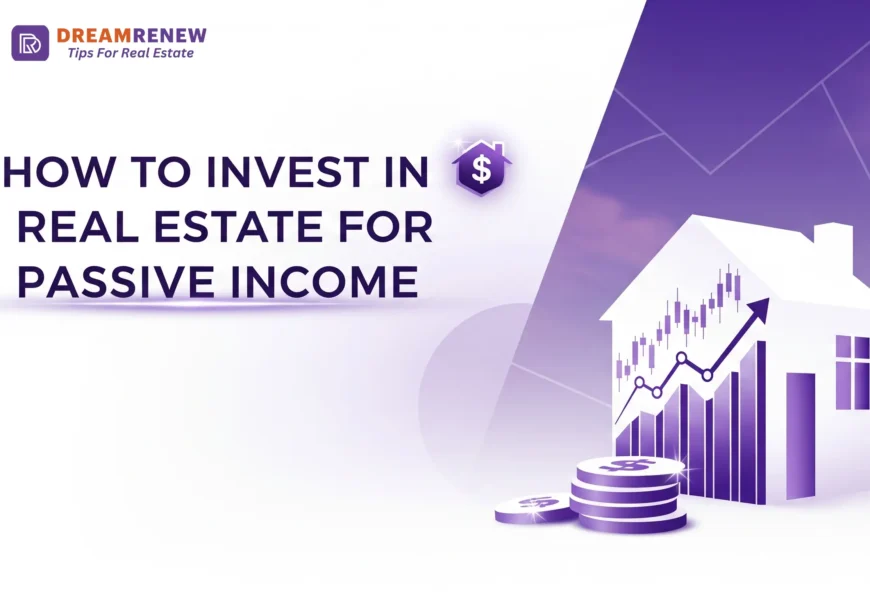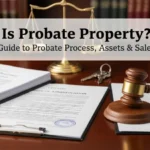Just remember, when you thought about making money while you sleep, then passive income has probably crossed your mind. One of the most reliable ways to build long-term passive income in the US is through real estate investment.
But here’s the best part… you don’t have to be a landlord or have millions of dollars to get started.
In this blog post, we’ll break down exactly how to invest in real estate for passive income, even if you’re just starting out.
Let’s start…
What Is Passive Real Estate Investing?
Passive real estate investing means putting your money into real estate without doing the daily work. You’re not fixing leaky faucets, collecting rent, or screening tenants. Instead, someone else handles all the management and you collect a portion of the profits.
Imagine it in this way: you are an investor, rather than a landlord.
For instance, you decide to invest in shares of a real estate company that owns apartment buildings. The company that makes rent, manages properties, and pays you a share of the profits as a dividend. You are making money, but you are not participating in the daily work.
Why Real Estate Is Great for Passive Income?
There are many ways to generate passive income such as investing in stocks, receiving dividends, or launching an online venture; however, real estate definitely stands out due to its unique features:
1. Regular Income
Rental properties produce regular monthly rental income, which is distributed to you if you have a passive investment. It is very much like receiving a salary without doing any work.
2. Long-Term Value Growth
Real estate prices are generally on an upward trend over a period of time. In that case, the property (or portfolio) you choose to invest in will most likely have a higher value after 5 or 10 years, thus enabling you to accumulate wealth.
3. Inflation Protection
When the cost of living goes up, the prices of rent follow the same pattern. This mean your rental income is generally still in line with inflation.
4. Tax Advantages
The U.S. tax law is designed to benefit real estate investors. You are able to deduct expenses such as depreciation, mortgage interest, and repairs that in turn lower your tax bill.
5. Diversification
Real estate is a good option for diversifying an investment portfolio. It usually behaves differently from stocks and bonds, thus potentially shielding your total wealth from risks.
Passive vs. Active Real Estate Investing
Let’s clear up an important distinction.
- Active investing means you’re directly involved buying houses, fixing them up, managing tenants, and selling properties. This takes time and hands-on work.
- Passive investing means you provide the money, and professionals do the work. You’re investing, not managing.
Passive investing is ideal for people who want to earn without adding a second job to their lives.
6 Ways to Invest in Real Estate for Passive Income
The number of routes to produce passive income by means of real estate are many. Each of them is different in the good, bad, and best conditions to start.
Here’s a breakdown of the most common strategies:
Invest in REITs (Real Estate Investment Trusts)
REITs are companies that own and manage income-producing properties like shopping malls, office buildings, or apartment complexes. When you buy shares of a REIT, you’re investing in those properties.
You earn money through dividends, which are a share of the rent and profits the REIT collects.
Why REITs are great for beginners:
- You can invest with just $100 or less.
- You buy shares like you would with stocks — through platforms like Vanguard, Fidelity, or Robinhood.
- No property management required.
Keep in mind: While REITs are generally stable, their value can go up and down like any stock.
Use Real Estate Crowdfunding Platforms
Crowdfunding lets you pool money with other investors to buy specific properties. A real estate company manages the property, and you get a share of the rental income and profits.
Popular platforms in the U.S. include:
- Fundrise
- Roofstock One
- RealtyMogul
You can start with as little as $500, making this option super accessible.
Pros:
- Low entry point
- Professional management
- Choose specific projects to invest in
Watch out for: Some platforms may lock in your money for 3–5 years, meaning you can’t cash out early.
Buy Turnkey Rental Properties with Property Management
Turnkey rental properties are move-in-ready homes that are already rented out and managed by a professional company.
Here’s how it works:
- Buy a property that already has tenants.
- Hire a property management company to handle everything (maintenance, rent collection, etc.).
- Receive monthly income after expenses.
Ideal for: People who want direct ownership of real estate but don’t want to be landlords.
Things to consider:
- Requires more upfront cash (typically 20% down payment).
- You still carry risk if the property sits vacant or needs repairs.
Invest in Real Estate ETFs or Mutual Funds
These are the funds that pool their money into a collection of REITs or stocks related to the real estate sector. Instead of purchasing a particular property, you are trading with a diversified group of real estate investments.
Benefits:
- Easy to buy and sell through a brokerage account.
- More diversified than buying a single REIT.
- Great for long-term passive growth.
This is best if you want to spread your risk and keep things simple.
Join a Real Estate Syndication
A real estate syndication is the situation when a group of investors come together to buy a big property such as a large apartment complex. One person or a company is the sponsor (the one who manages the project), and you join as a passive investor.
You give money, they look after the property, and the profits are divided according to the amount of your investment.
Did you know? Such kinds of deals are often private and may require a higher minimum investment (usually $25,000+). However, if you do it correctly, they can bring you good profits.
Try Fractional Ownership
Fractional ownership means that you have the rights of a small share in one property, typically through a digital platform.
Let’s say a house is valued at $200,000 and you put in $5,000, then you become the owner of 2.5% of the property. You will get 2.5% of the rental income and the revenue from the sale of the property.
Such platforms as Arrived Homes and Lofty AI simplify the process for novices. It’s a wise move to dip your toe in the real estate market by investing
How to Get Started (Step-by-Step)
Step 1: Define Your Goals
Do you want monthly income now, long-term growth, or both? Your answer will guide which type of real estate investment is best for you.
Step 2: Know Your Budget
If you only have $500 to invest, crowdfunding or REITs are your best bet. If you have $25,000 or more, you can consider syndications or turnkey properties.
Step 3: Research Your Options
Take time to understand each method. Look at fees, past returns, risks, and how long your money will be tied up.
Step 4: Start Small
There’s no need to jump in big. Try a small REIT investment or test a crowdfunding platform to gain confidence.
Step 5: Diversify
Don’t put all your money into one property or one type of investment. Spread it across multiple sources to lower risk.
What Are the Risks?
Every investment has some risk. Here’s what to watch for in passive real estate:
- Vacancies
- Market Drops
- Fees
- Limited Liquidity
- Less Control
- Tax Benefits for Real Estate Investors
Real estate comes with some helpful tax perks in the U.S.:
- Depreciation
- Mortgage Interest Deduction
- 1031 Exchange
Talk to a tax advisor for details based on your personal situation.
Final Thoughts
One of the most effective ways to generate passive income is through real estate and it is definitely more accessible at present than before. A strategy can be found for any budget that ranges from $500 to $50,000 which would be suitable to start off with.
Real estate has long stood as a classic path to accumulation of wealth in a slow and steady process. Your central focus would be on learning and then applying the knowledge at a small level. Then you choose the strategy that is compatible with your major goals.
Always remember: the sooner you start, the sooner your money starts working for you.




